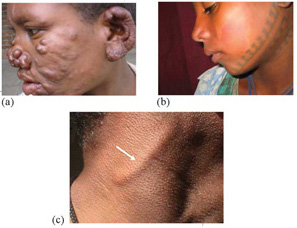18.3.2 Diagnosing leprosy
Diagnosis of leprosy is most commonly based on the clinical features. The signs and symptoms will be easy for you to look for and observe after a short period of training, based on the descriptions in this section. In rare instances, laboratory and other investigations are necessary to confirm a diagnosis of leprosy. An individual should be regarded as having leprosy if one or both of the following very significant cardinal signs are present:
Doctors often call key signs such as these cardinal signs; the term can be applied to the key signs of any disease or health condition.
- skin lesion: an area of skin with definite loss of sensation (lack of feeling), with or without thickened nerves (we will explain about such nerves shortly);
- positive skin smears: in a small proportion of cases, leprosy bacteria may be seen in the smears taken from the affected skin when examined under a microscope.
Other symptoms and signs of leprosy are:
- Numbness or tingling of the hands and/or the feet
- Weakness of eyelids, hands or feet (tests for muscle weakness are described later)
- Painful and/or tender nerves
- Burning sensation in the skin
- Painless swelling or lumps in the face and earlobes (see Figure 18.2a)
- Painless wounds or burns on the hands or feet
- Loss of eyebrows and or eyelashes.
The skin lesion can be single or multiple, usually less pigmented than the surrounding normal skin (see Figure 18.2b). Sometimes the lesion may be reddish or copper-coloured. The variety of skin lesions which may be commonly seen include macules (which are flat), papules (raised), and nodules.

Features of the skin that are not indicative of leprosy
Skin patches:
- that are birth marks
- where there is normal feeling
- that itch
- that are white, black or dark red
- with scaling
- that appear or disappear suddenly and spread fast.
If you are not sure about the cause of the skin lesion, you should refer to a clinician.
Thickened nerves (see Figure 18.2c) constitute another feature of leprosy. These occur mainly on peripheral nerve trunks, which are nerve bundles close to body surface. Nerve thickening is often accompanied by other signs of damage, such as a loss of sensation in the skin and weakness of muscles supplied by the affected nerve. Nerve thickening by itself, without sensory loss and/or muscle weakness is usually not a reliable sign of leprosy.
18.3.1 Case finding
